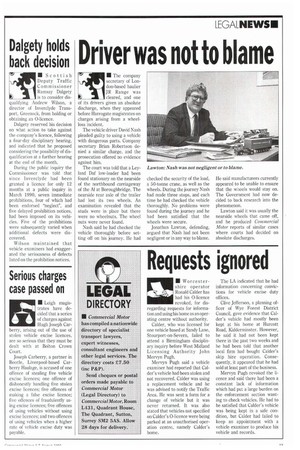Driver was not to blame
Page 15

If you've noticed an error in this article please click here to report it so we can fix it.
• The company secretary of London-based haulier JR Range was cleared, and one of its drivers given an absolute discharge, when they appeared before Harrogate magistrates on charges arising from a wheelloss incident.
The vehicle driver David Nash pleaded guilty to using a vehicle with dangerous parts. Company secretary Brian Robertson denied a similar charge, and the prosecution offered no evidence against him.
The court was told that a Leyland Daf low-loader had been found stationary on the nearside of the northbound carriageway of the Al at Boroughbridge. The nearside rear axle of the trailer had lost its two wheels. An examination revealed that the studs were in place but there were no wheelnuts. The wheel nuts were never found.
Nash said he had checked the vehicle thoroughly before setting off on his journey. He had checked the security of the load, a 50-tonne crane, as well as the wheels. During the journey Nash had made three stops, and each time he had checked the vehicle thoroughly. No problems were found during the journey and he had been satisfied that the wheels were secure.
Jonathan Lawton, defending, argued that Nash had not been negligent or in any way to blame. He said manufacturers currently appeared to be unable to ensure that the wneels would stay on. The Government had now decided to back research into the phenomenon.
Lawton said it was usually the nearside wheels that came off, and he produced Commercial Motor reports of similar cases where courts had decided on absolute discharges.












































































